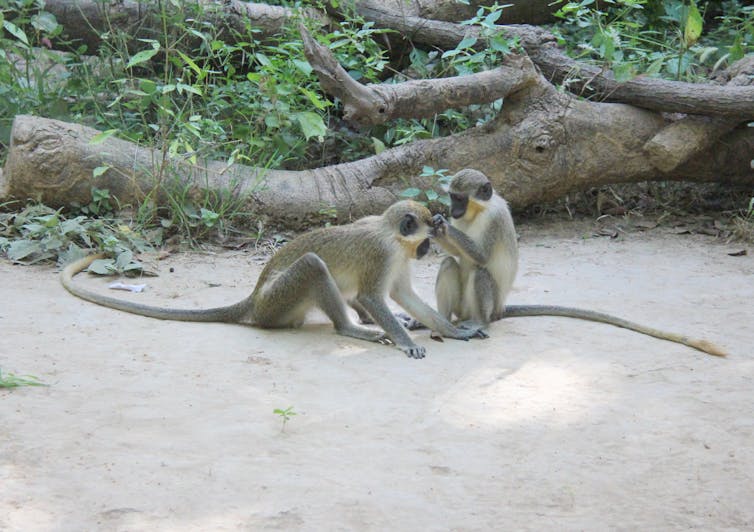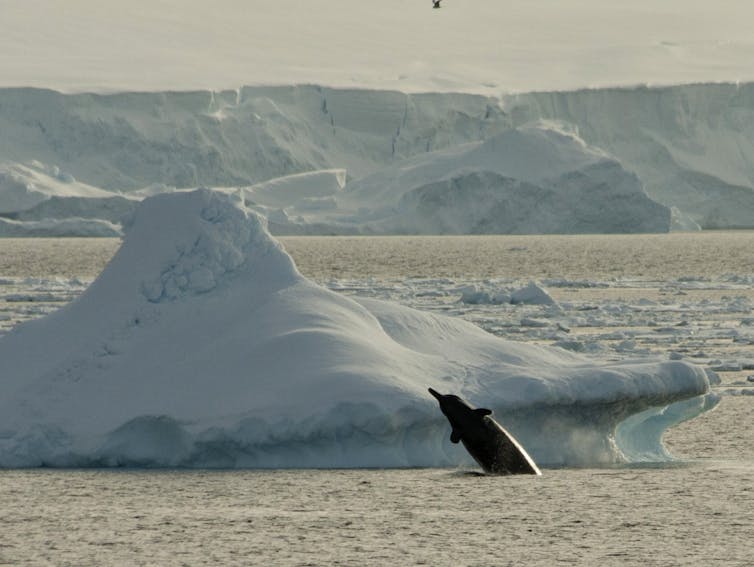Animals do the most amazing things. Read about them in this series by Janaki Lenin.

A sperm whale. Credit: lakpura/Flickr, CC BY 2.0
Could a 56-ton Moby Dick ram and sink Ahab’s Pequod that would have weighed nearly 240 tons? Using computer simulations, a study says sperm whales have the ability to ram ships without suffering serious harm.
Nineteenth century whalers claimed sperm whales deliberately collided with whaling ships and sank them. The first such recorded incident occurred in 1820. A large 26-metre sperm whale sank the 238-ton whaling ship Essex in the South Pacific. The hull of the ship was made of white oak, one of the strongest woods available then. Owen Chase, the ship’s first mate, proposed the heads of these giants were uniquely designed for use as battering rams. More than 30 years after the sinking the Essex, a sperm whale sank another ship, the Ann Alexander.
In many species, male animals are physically different from females, a phenomenon called sexual dimorphism. Typically, such males fight over mates and their weapons are huge relative to body size. For instance, blackbuck have to defend their harem of tan-coloured does from rivals. While does have no horns, the bucks have a prominent set of ringed corkscrew-like horns.
Similarly, male sperm whales are three-times larger than females and skirmish over mates. Since the bulls have the world’s largest nose, they could use their massive snouts to butt each other – so suggest the authors of the paper. In similar contests, male humpback whales, narwhals and killer whales ram each other. However, there were few records of such fights between sperm whales.
“There is no physical reason sperm whales could not butt each other in aggressive or non-aggressive encounters,” Luke Rendell, of the University of St. Andrews, UK, told The Wire. “However, aside from the single account offered by the pilot in the paper, there is no report of this behaviour from any of the long periods of time researchers have spent with the animals. Hal Whitehead [Dalhousie University, Canada] describes an account of one whale grasping the tail stock of another in its jaws, while I have personally observed two males swimming toward each other blasting each other with very rapid and very loud clicks – but no butting.”
On January 30, 1997, wildlife pilot Sandy Lanham spotted two male sperm whales as she flew over the Gulf of California, Mexico. She estimated they were more than 6 km apart and swimming toward each other at 17 km/hr. They dove just below the surface before colliding head-on with each other. Could this be a common behaviour? Biologists are skeptical because sperm whales’ heads house sensitive communication and navigation tools.
Sperm whales dive to over 1,000 metres and are the second-deepest diving animals. While hunting in the dark depths, they need to communicate with others in the pod and also find their prey, giant squids. Through a pair of lip-like valves located in the head, they make click sounds. Different populations have distinct dialects and each sperm whale has its own unique accent or pattern of clicks. Their echolocation gear and buoyancy control sit at the front end of their noses.
In addition, two enormous oil and wax-filled organs – the spermaceti organ and the junk sac – take up most of the space in their gigantic noses. From the early 18th century, whaling ships targeted sperm whales for their spermaceti. Oil drained from their heads lit the streets of London, New York, Berlin and Paris, and became a key ingredient in candles, soaps and lubricants. Whalers thought the oil was semen and hence the name ‘spermaceti’. On the other hand, whales use the two oil-filled glands to direct and amplify their sonar clicks and stun their prey with a high decibel buzz. If these whales used their heads to batter each other, they could cause irreparable damage to these sensitive communication, stunning and navigation structures.

Schematic representation of sperm whale head structure. Credit: Ali Nabavizadeh
“The forehead of the sperm whale is one of the strangest structures in the animal kingdom,” says Olga Panagiotopoulou, University of Queensland, Australia, and the main author of the latest paper.
Back in 2002, David Carrier, professor of Biology at University of Utah, US, suspected that sperm whales must somehow absorb the shock to their brains and skulls. In spring 2003, Carrier’s brother and Lanham met at a friend’s house and somehow the conversation turned to sperm whales. Carrier learnt of Lanham’s story when his brother alerted him. “We then knew that our ramming hypothesis had some merit and looked into the available technology to test it,” says Carrier.
An interdisciplinary research team, including Carrier, used structural engineering principles and computer models to test how the sperm whale’s head might withstand the impacts of ramming. The junk sac has a series of vertical partitions made of connective tissue. The researchers say these tissues reduce stress to the skull and protect bone and soft tissue when a whale rams against another. Without these partitions, stress to the skull was 45% greater and could cause fatal fractures.
“[O]ur findings show that connective tissue partitions within the junk of the sperm whale forehead may function as a shock absorber,” says Panagiotopoulou. “Although male sperm whales may not fight frequently, we know that aggressive ramming behaviour is a common characteristic in the group of mammals from which whales are derived – the even-toed ungulates, the artiodactyls. A closer look into the anatomy of the heads of other species of whales that ram may reveal a variety of protective mechanisms.”
However, Rendell isn’t convinced. “The authors showed that, in theory, a structure with partitions in it is better at absorbing shock than one without,” he says. “But then they spin this into an evolutionary just-so story which has absolutely minimal empirical support by claiming that the sperm whale head evolved as a ramming device for males. The fact that females have one too is just a ‘male nipple’ epiphenomenon, and the fact that the whole thing is brilliant for echolocation in both sexes is a fortuitous coincidence.”
“It is scientifically incorrect for a biologist to reject a hypothesis and call a peer-reviewed study ‘fortuitous coincidence’ without scientific evidence to back up such claims,” counter Panagiotopoulou and Carrier. They add that sexually dimorphic traits evolve for a reason and they could have multiple functions.
Witnessing a ramming
Devising a model for simulating impacts on a sperm whale head wasn’t easy. Little is known of the anatomy and structure of sperm whale foreheads. “To study the mechanical role of the connective tissue partitions during quasi-static impact stresses,” says Panagiotopoulou, “we used a novel combination of finite element analysis and probabilistic simulation. These are approaches engineers use to test the endurance of bridges and tunnels, but functional anatomists also use such approaches to investigate the deformations of anatomical tissues during dynamic events. Due to the limited published information on the structural configuration of the sperm whale forehead, we conducted a series of sensitivity analyses on the type and direction of impact force on the sperm whale head to ensure model accuracy.”
Even more challenging than designing and testing the theory is witnessing two oceanic mammoths having a go at each other. There may be a reason why biologists haven’t witnessed a ramming incident. “If these ramming contests generally occur at a shallow depth, they may be much more common than whale biologists realise because a human observer would have to be located well above the surface of the water to watch it happen,” say the authors of the paper.
“I doubt this could explain it,” says Rendell. “The whales in the pilot’s account dove when they were an estimated 6 metres from each other. We have definitely noticed whales swimming straight toward each other in this way, coupled with incredibly loud acoustic displays. But there was no dive and no head-butting. Also, we observe from elevated platforms, and have observed head-butting in another species – northern bottlenose whales.”
In this case, the bony anatomy of the male head is indeed consistent with head-butting – so the notion that current observation methods would have missed a significant amount of head-butting in males does not bear scrutiny.” So the bottomline is: sperm whales can ram each other, but whether they do as a normal part of their aggressive repertoire remains uncertain. The paper was published in the journal PeerJ on April 5, 2016.
Janaki Lenin is the author of My Husband and Other Animals. She lives in a forest with snake-man Rom Whitaker and tweets at @janakilenin.










